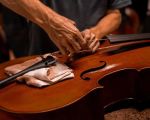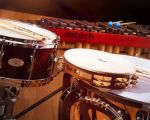What is Music Transposition?
Music transposition refers to the process of changing the key of a piece of music, adjusting it for different instruments or vocal ranges. Whether you're a musician looking to play a piece in a different key or adapting music for a group performance, transposing is a valuable skill to have. In this article, we’ll break down the basics of music transposition and how you can transpose music for different instruments effectively.
Why Transposing Music is Important
Transposing music allows musicians to perform pieces that may be written in keys that are not suited to their instruments or vocal ranges. Different instruments are tuned to different keys, and transposition helps musicians play the same melody or harmony across various instruments. For example, a piece of music that is written for a piano might need to be transposed if you want to perform it on a trumpet or a guitar. Transposing also helps when arranging music for different ensembles and ensuring that each instrument can participate comfortably.
Basic Transposition Techniques
Understanding how to transpose music requires knowing a few basic techniques. Here are the essential steps to follow:
- Identify the Original Key: The first step is to figure out the key of the original music. This will tell you how many steps you need to move to get to your new key.
- Choose Your Target Key: Decide which key you want to transpose the music to. For example, if the original piece is in C major and you need it in G major, you'll need to move the entire piece up by five steps.
- Adjust the Notes: Once you've established the original and target keys, shift each note accordingly. For instance, every C note will move to G, and every D note will move to A. This is crucial for ensuring the piece sounds correct after transposition.
How to Transpose for Different Instruments
Each instrument in an orchestra or band might have a different tuning system, making transposition an essential skill. Here’s a breakdown of how to transpose for some common instruments:
Transposing for Woodwind Instruments
Woodwind instruments such as the clarinet, flute, and saxophone are tuned to different pitches. For example, the B-flat clarinet is a transposing instrument, meaning that if it reads a C, it actually sounds a B-flat. To transpose music for the B-flat clarinet, you would need to move everything up by a major second (or whole step).
Transposing for Brass Instruments
Brass instruments, like the trumpet and euphonium, are also transposing instruments. The trumpet, for example, is typically pitched in B-flat. When transposing music for a trumpet, you’ll need to raise the pitch by a major second (a whole step) to account for the trumpet's unique tuning.
Transposing for String Instruments
String instruments like the violin, cello, and guitar generally don’t require transposition when reading music, as they are typically tuned to the same pitch as the written music. However, when writing for a guitar, it’s common to transpose music up one octave to accommodate its unique sound and range.
Case Study: How to Transpose for Different Instruments in a Band
Imagine you’re arranging a piece of music for a small band that includes a piano, trumpet, and clarinet. The music is originally written in C major. To ensure the music sounds correct across all instruments, you would transpose the trumpet part up a major second (from C major to D major), the clarinet part up a major second as well (from C major to D major), and the piano part would remain in C major since it’s a non-transposing instrument. This way, when all the instruments play together, the music will sound harmonious and in tune.
Transposing Tips for Beginners
If you're new to transposing music, these tips can help make the process smoother:
- Start Simple: Begin by transposing simple pieces of music to get comfortable with the concept. Try transposing songs with fewer accidentals to practice.
- Use a Piano: If you're unsure about the new notes, using a piano to play the transposed notes can help you check the accuracy of your transposition.
- Practice Regularly: Like any musical skill, transposition improves with practice. Regularly practicing transposition exercises will make it feel more natural over time.
Tools to Help with Transposing Music
If you find transposing challenging, there are a variety of tools and resources that can assist. Online transposing tools and music notation software can automate the transposition process, making it easier for you to experiment with different keys and instrument settings. Websites like Beat Trigger offer great options for music software and tools that can simplify this process for musicians of all skill levels.
Real-Life Experience with Transposing Music
A composer once shared how transposing music for a jazz ensemble led to an entirely new sound for a composition. Originally written for piano, the piece was transposed to fit a saxophone and trumpet, which gave the music a more dynamic and energetic feel. This case highlights how transposition can not only make a piece playable on different instruments but also alter its character and mood based on the instruments used.
Conclusion
Transposing music for different instruments may seem complex at first, but with practice and an understanding of the basics, it can become a useful and rewarding skill. Whether you're a composer, arranger, or performer, knowing how to transpose music effectively ensures that you can adapt any piece for a variety of instruments. Start by practicing simple transpositions, and over time, you’ll gain confidence in your ability to transpose for different instruments. For more tools and resources to enhance your music skills, be sure to check out Beat Trigger for the best music-related services and products.








